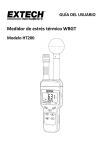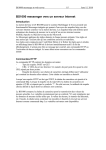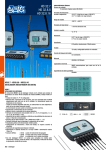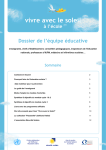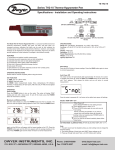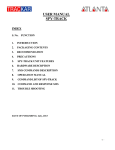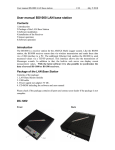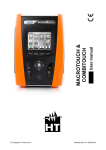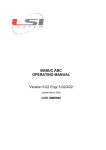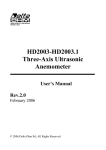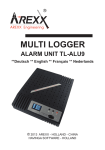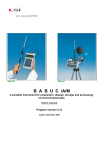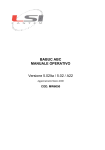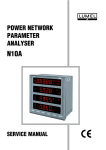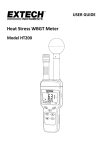Download MANUALE BABUC/E INGLESE
Transcript
LSI SpA - Loc. Dosso - 20090 Settala (MI) - Italy Fax +39 - (0) 2 9 5 7 7 0 5 9 4 E.Mail [email protected] INTERNET URL http://www.lsi-lastem.it MW6045 B A B U C / E Portable multi-data indication unit User's manual Program Version 5.07 Update 04/07/2003 Index 1.Introduction 2.Functions 3.General characteristics 4.Technical characteristics 5.How to switch on the instrument 6.How to switch off the instrument 7.Set day/time 8.ANALYTICAL DESCRIPTION Set pipe dimensions and room volume 9.Use of BABUC/E 1. Introduction BABUC/E is a compact indication unit for physical, environmental and chemical parameters including temperature, humidity, air speed, pressure, gas concentration, light intensity, rotation, etc. Like all models in the BABUC line, this version features an automatic channel initialize system for sensor recognition, with the possibility of connecting a selection from 80 different available sensor types 1) of the line The instrument simultaneously displays all instantaneous values and statistical values such as average, minimum, maximum and so forth. BABUC/E has three input channels: two for analogueue sensors and the third for digital pulse generating sensors. BABUC/E is portable and is supplied with a handy shoulder strap. Its internal batteries provide lasting autonomy without requiring power from the mains network. 1) Hot wire anemometer (code BSV101) exclude. 2. Functions - Auto-recognition of connected sensors Display of instantaneous and statistical values Measurement selection for the statistic calculation 3. General characteristics ACCEPTED PARAMETERS: Sensors for various parameters and based on different physical systems can be connected simultaneously to BABUC/E; the instrument will recognize types of connected sensors and initialize its circuitry and the type of processing adopted. The last pages of the bulletin entitled MULTILOGGER-ANALYSER BABUC contain a list of sensors manufactured by LSI that can be connected to BABUC/E. The sensors measure the following parameters: 1 - Temperature 2 - Relative humidity 3 - Thermal flow 4 - Radiation 5 - Light intensity 6 - Differential/barometric pressure 7 - Air speed 8 - Gas concentration 9 - Noise levels 10 - pH 11 - Rpm 12 - Level 2 BABUC/E PROGRAMMABILITY: various settings are possible. a) Input of current date/time so that the instrument can associate minimum and maximum values with the exact time of measurement. b) Input of standard values for parameters that are not acquired but that serve for computations (gravity, ambient temperature, height above sea level, and barometric pressure) and are helpful when making measurements with Pitot tubes, for calculating pH, and other parameters that cannot be calculated without reference values. c) Beeper activate/mute. d) Calibration factor for radiometer. INPUTS: BABUC/E has three input channels: two for analogue sensors and one for a pulse generating sensor. Pulse sensors in the BABUC line are fan anemometers (BSV201, BSV207) and tachometric sensors (BSV301). All other (analogue) sensors can be connected to the remaining two channels. Model BSV101 hot-wire anemometer cannot be used with BABUC/E. This instrument is able to accept sensors which, although not produced by LSI, are present in its library of codes. Each present code foresees : the electric signal output from the sensor, the range and description of the measurement unit of the described parameter. SELECTION OF MEASUREMENT FOR THE STATISTICS CALCULATION : It is possible to block the access to the database of the instantaneous values that the operator does not retain acceptable for the calculation of the statistical values. In other words, the operator will be able to continuously display the instantaneous values, and when they are no longer representative, he will be able to stop the calculation of the average, the minimum, the maximum, etc. by means of the "F2" key. In addition it is possible to verify how many instantaneous values have been acquired for that particular calculation. DISPLAYS: during the surveys the operator can display data in two formats: "short form", showing the list of values of the latest acquisition for all parameters; "statistical form", showing, for each parameter, the latest acquisition value with the variation against the previous reading, minimum and maximum values with relative times, average value and standard deviation from the start of the survey or the last update. DERIVED PARAMETERS CALCULATION RADIANT ASYMMETRY CALCULATION: From Version 2.1 of the program, when connected the radiant asymmetry probe (BSR231 with references to the EN 27726), and an air temperature probe, BABUC shows and, in case, stores (if a survey with storage is in progress), the following values: - Net Radiation W/m 2 - Radiometer temperature in °C - Air temperature in °C - Planar radiant asymmetry temperature (∆tpr ) (UNI EN 27726) UVA DENSITY CALCULATION: From version 4.02 of the program, when BABUC is connected to the following probe: Lux/UVA combined probe (BSR107) It calculates, displays and stores (if a survey with storage is performed) the derived parameter “UVA Density”. It expresses the emission of ultraviolet radiation (UV-A) with respect to the lighting level of the lighting sources in the rooms where objects are present which may deteriorate due to photochemical reactions. 3 BABUC/E DR CALCULATION: From Version 5.06 of the program, BABUC when connected to the following probes: - Air speed and turbolence (BSV105) - Temperature Calculates, visualizes and memorizes (if a survey with storage is performed), the risk index from air currents (UNI EN Iso 7730 September 1997) CALCULATION OF DISSATISFIED DUE TO RADIANT ASYMMETRY: From the version 5.03 of the BABUC program, when connected to a Net radiometer probe, calculates the following index: - Percentage of dissatisfied due to radiant asymmetry (%) (UNI EN 27730) – only Vers. > 5.06 DAYLIGHT FACTOR CALCULATION: From version 5.06 of the programme, BABUC, when connected to the following probes: Luminance for internal (BSR000, BRS001), Luminance for external (BSR003, BSR005) It calculates and visualizes the daylight factor (Ministerial Decree 5 July 1975 Art.5) LUMINOUS INTENSITY CALCULATION: From version 4.02 of the program, when BABUC is connected to the following probe: Luxmetric probe It calculates, displays and stores (if a survey with storage is performed) the derived parameter “luminous intensity”. It expresses the luminous flux of a source in a specific direction, per unit of solid angle. In the calculation this measurement uses the standard parameter “Distance from light source” which must then be set. If the “Distance from light source” is equal to zero, the “luminous intensity” parameter is not calculated nor is it displayed or stored. AIR DELIVERY, AND NUMBER OF AIR CHANGE CALCULATIONS: In version 4.0 of the program, when BABUC is connected to anemometric probes (hot wire, fan and Pitot tube anemometers) and to a temperature probe and after setting the dimensions of the pipes and rooms other than zero, the instrument will calculate the following parameters: - Air flow: After setting the geometry and dimensions of the unions, pipes and rooms, BABUC will calculate the volumetric (m3/sec.) and mass air delivery (Kg/sec.). The pipe factor can be set from 0.1 to 1 (ASHRAE Handbook) - Number of air changes: After setting the volume of a room, BABUC calculates the number of air changes (N/h) WBGT Calculation: From version 3.9 of the program, when BABUC is connected to the following probes: - Globothermometric probe and Natural ventilation wet bulb probe - Dry temperature probe. It calculates, displays, and stores (if a survey with storage is performed) the WBGT thermal stress index (ISO7243) in the WGBT indoor and WBGT outdoor versions. If BABUC is connected to the following probes : - Globothermometric probe and Natural ventilation wet bulb probe It calculates, displays, and stores (if a survey with storage is performed) the WBGT thermal stress index (ISO7243) only in the WGBT indoor version. CALCULATION: HEAT AND HEAT STRESS INDEX: When the instrument is connected to the following probes: - Relative humidity (RH %) BSU400, BSU401, BSU431 - Air temperature (Ta °C) esso calcola, visualizza e memorizza (durante un rilievo con memorizzazione) le grandezze derivate: it calculates, displays and stores (during a survey with storage), the derived quantities: - Heat Index (°C) - Heat stress index 4 BABUC/E The heat sensation is mainly due to a series of factors, among which, the air temperature and rhe relative humidity. In sultry weather conditions, indeed, the sweat produced by the organism to lower the body temperature cannot evaporate in the sorrounding environment because already saturated. In these conditions, and without the cooling contribution of the sweat, the body temperature tends to higher with the possibility of heat strokes in case certain extreme values are overloaded. So, an heat index has been created to underline the temperature felt by the body instead of the real one. For example, with a temperature of “only” 29 °C and a humidity level of 70% the human body feels 34°C. It is possible to note how, at any temperature with 90% of humidity, the risks for an organism are very high, and go from a heavy fatigue with breath difficulties to a possible heat stroke or sunstroke. In case of low humidity, instead, the sensation felt by the organism, can also be lower than the real temperature. For example, with a humidty level of only 10%, 38°C will be perceived as “only” 36°C. The heat index can be calculated with the following formula: Heat index =-42.379 + 2.04901523xTf + 10.14333127xRH - 0.22475541* Tf *RH –0,00683783*Tf^2 – 0,05481717*RH^2 + 0,00122874*Tf^2*RH + 0.00085282*Tf*RH^2 – 0,00000199*Tf^2*RH^ Fahrenheit degrees. Tf =Air temperature in Fahrenheit degrees RH =relative humidity Formula from Celsius to Fahrenheit degrees and viceversa Ta = 5/9*(Tf-32) Tf = (9/5)*Ta+32 With the heat index calculation, the Heat stress index can be calculated with the following table: Exposition desciption Heat index Discomfort description Exposition desciption Less than 27 degrees 0 = nul No risks Between 27 and 31 degrees 1 = light Possibile fatigue, heat cramps Between 32 and 39 degrees 2 = medium Strong fatigue, breath difficulties Between 40 and 54 degrees 3 = strong Possibile heat stroke, sunstroke More than 54 degrees 4 = extreme Heat stroke highly probable CALCULATION – UV INDEX AND EXPOSITION LEVEL Babuc, when connected to the UV-A (W/m 2) and UV-B (W/m 2) broad band radiometer, calibrated and programmed (Reference INTERSUN-GLOBAL UV project UV-index, ANNEX C )calculates, displays and stores (during a survey with storage) the derived quantities: - UV Index - UV Exposition level The UV index expresses the intensity of the solar ultraviolet radiation. This index is internationally adopted so to transmit to the population information about the possible health damages (skin and eyes), in case certain levels are surpassed. The UV index expresses the dangerousness of solar radiation during the solar noon (maximum elevation of the sun over the horizon), and coincides, in clear days, with the maximum level of ultraviolet radiation. The UV index can assume values from 0 to 12; increasing values of the UV index express increasing risks to the solar exposure. The values quoted in the below tables are about the relative times of exposition suggested to avoid damages; they have to be considered indicative, being, indeed, referred to skin exposed to the sun for the first time during the season, unprotected by creams and that still do not have developped a certain natural resistance to the UV radiation; for already tanned skins, these times can be doubled. 5 BABUC/E The skin types can be so summarized: Skin type I II III IV Gets tanned never sometimes always always Burns always sometimes seldom never Hair red blondes brown black Eyes blue blue/green brown brown Level ofsuggested exposition referred to people with sikn type I and II UV Index 0-2 3–5 6–7 8 – 10 > 11 Uv level of exposition 0 = low 1 = light 2 = high 3 = high++ 4 = extreme Limits of exposition > 60 minutes 30-60 minutes 30 minutes 20 mminutes <15 minutes 4. Technical characteristics No. of inputs A/D converter Clock Display Acquisition rate Keypad Power supply voltage Average power consumption Battery autonomy Operating conditions Construction Dimensions Weight Resolution and accuracy of the inputs 3 12 bit SW clock to be reset at each switch LCD 20 char. X 4 lines 1 sec. 21-key numerical 1 internal 9V alkaline batteries (External power socket 9 Vdc) 30 mA (without powered probes) 8 hours of continuous duty (without powered probes) 0-50°C (opt. -20 ... + 50°C) Anodized aluminum casing 215 x 110 x 30 mm 550 g See data bulletin entitled MULTILOGGER-ANALYSER BABUC 6 BABUC/E 5. How to switch on the instrument Connect the probe to its inputs. Press the "ON" key. After a brief countdown, the following message will appear on the screen: M a r o g r B a A m B P t r . * * * * . U * C V . * * * * . * * t showing the number of the resident program, the serial number of the instrument, and the program language. If "IMMIS" is pressed, the main menu will be shown. If the operator does not press "IMMIS", the instrument will be automatically switched off after one minute as a safeguard against inadvertent activation. 6. How to switch off the instrument 1.1 S S > S U y t h t n a u i t t t l e i d i t s o t i t w y c i n ' C a l Return to the main menu to switch off the instrument. Shift the cursor to "SHUTDOWN" and press IMMIS WARNING: Wait 10 seconds before switching the instrument on again. 7. Set day/time It is used for giving a day/time to the max. and min. values. Connect the probe to its inputs. Press the "ON" key. After a brief countdown, the following menu will appear on the screen: Go to "UTILITY'" and press IMMIS. 1.2 > S B E B y a r e s t r e t t o p e e r e m r d y m a A V N t o a e l g / t e t a m i g e m e n e 0 0 : t e m m m : - - : 0 a s - 0 t r Select "SYSTEM DATE/TIME", press IMMIS. 1.3 0 0 D a g g - - / t / / 0 0 / a / O m m / - - / 0 r a - 0 a a - 0 S H - 0 i h - : s : : s - Type current date and time and press IMMIS to come back to thye 1.2 mask. Press ESC to come back to the mask 1.1 7 BABUC/E 8. ANALYTICAL DESCRIPTION Set pipe dimensions and room volume When anemometric probes are connected to BABUC/E, it shows and stores (if survey with storage) the followings quantities : - Volumetric air delivery (mc/sec) - Mass air delivery (Kg/sec) - ATTENTION : only if a temperature probes is still connected - Air replacement number (N/h) - Air Changes User should insert the pipe dimensions and form in which he is going to measure air delivery and the room volume in which he is going to measure the number of air replacement . A temperature probe is needed if mass air delivery should be calculate; BABUC use the probe nearest to the anemometer input. The pipe form and room volume is inserted and stored into the SYSTEM-> STANDARD QUANTITIES option . For a fast use it is possible to enter those information’s into the VISUALIZATION option also. T G A A L L R > P e r t l a o o i m a h t t n o p p v m i i g m e e i . t t i s s r t P u u t a y r d d u v d t U r a P C R P p R C P e s d i m E n s C O L A R ( d ) T A N G U L A R E F A C T O R e e e d o i S s u r e O S L E L u m e M e n s i o n s Press IMMIS i I E I . : : : ( c m ) 0 0 0 0 x 1 . 0 0 0 0 Type the request information’s and then press IMMIS. In case of mistake when press IMMIS the screen do not return to list of standard quantities. During the survey, if the pipe geometry is not been inserted or equal to zero, BABUC does not show the air delivery or number of air replacement. In case of absence of air temperature probe, BABUC shows an error message corresponding to the mass air delivery. 8 BABUC/E 9. Use of BABUC/E 1) Insert probe/s in the inputs 2) Switch on the instrument 2) Press two time IMMIS, the following mask will appears : 1.1 > S S S U y t h t n a u i t t t l e i d i t s o t i t w y c i n ' c a l 4) Select "SYNTETIC" and press IMMIS (example with psychrometric probe BSU102) 1.4 1 1 1 1 T D R T W E U R E T P R Y T L 2 2 1 7 0 5 7 . . 5 . 3 9 . 8 3 1 3 0 " " % " C C R C e l The list of the instantaneous values is display 5) Press ESC to turn back to the 1.1 mask. Go to "STATISTICAL" and press IMMIS to display the statistical information 1.5 1 I M M M D D T s i a e S i t n x d t f D 2 2 2 2 R 6 6 8 7 0 0 Y . . . . . . " 6 0 2 2 5 0 C * 9 5 3 8 2 5 On the first line it displays : - Number of the channel: 1 - Description of the parameter: (TDRY) "Dry temperature" - Unit of the parameter : °C - Activity of the statistical calculation (*) 6) Press "F2" to stop the statistical calculation. When a read-out is non representative the user should press "F2" in order to avoid non-representative values into the data memory for statistical calculation. 7) Press "F1" to reset the statistical calculation. 8) Press "pg " to display other channels 9) Press "ESC" and go to SHUTDOWN (in the mask n. 1.1) and press IMMIS to switch off the instrument. 9 BABUC/E









